

EMI Cassette Tapes
Original Album Series
#07. Please Please Me (TC-PCS 3042)
(Update: 15th. December 2024)




|
TITLE
|
PLEASE PLEASE ME |
|||
| CATALOG NUMBER | TC-PCS 3042 / 1E 262 o 04219 |
|||
|
RELEASE DATE
|
October 1970 / First Issue | |||
| TRACK LISTING | SIDE 1 | SIDE 2 | ||
| Misery [A2] |
Please Please Me [A7] |
|||
| Chains [A4] | Love Me Do [B1] (sim.stereo) | |||
| P.S. I Love You [B2] (sim. stereo) | A Taste Of Honey [B5] | |||
| Do You Want To Know A Secret [B4] | There's A Place [B6] | |||
| I Saw Her Standing There [A1] | Anna (Go To Him) [A3] | |||
| Ask Me
Why [A6] |
Boys [A5] | |||
| Baby It's You [B3] |
Twist And Shout [B7] |
|||
| CASSETTE CASE AND TAPE |
CASE FRONT | CASE BACK | SIDE 1 --> Click! | SIDE 2 --> Click! |
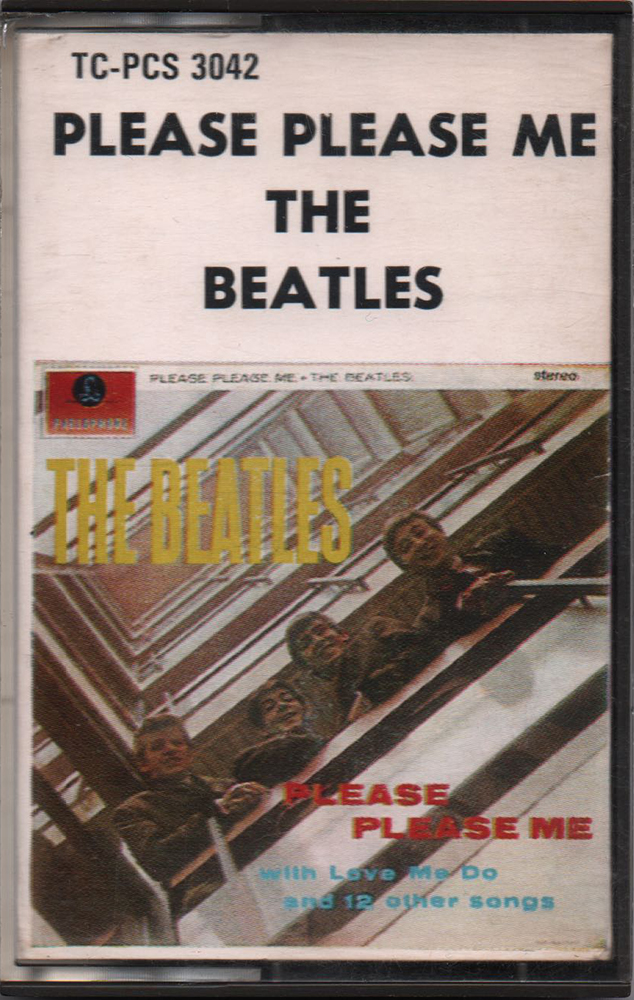 |
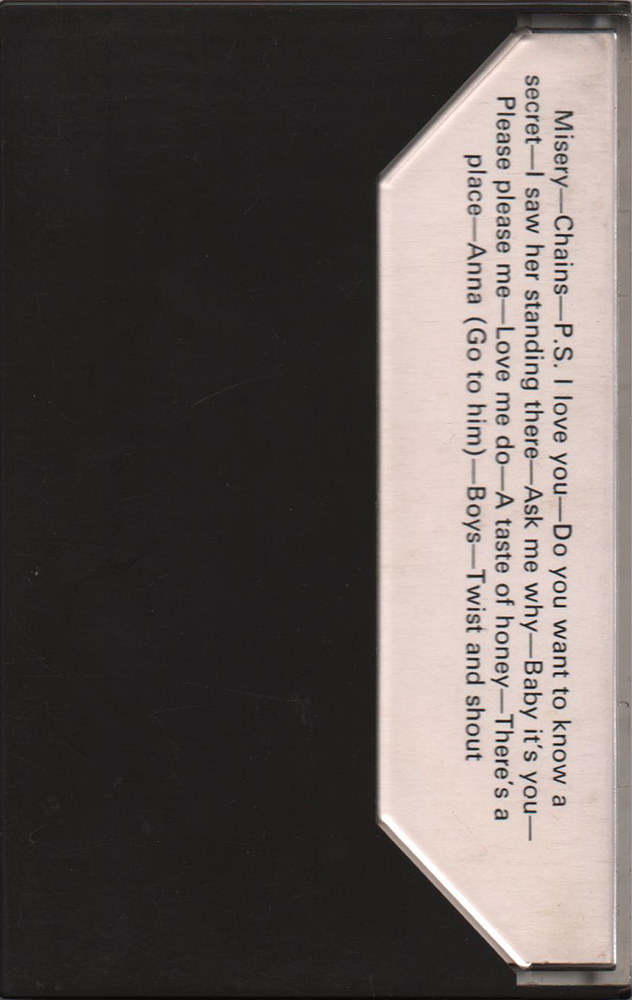 |
 |
 |
|
| The cassette cases ("Norelco" cases)
were clear plastic at the front and around the spine area,
and black plastic at the rear. |
The first UK issue has Lemon Yellow paper label without
Parlophone logo. Has the 3 windows shell. |
|||
| INLAY |
INLAY: FRONT | INLAY: INSIDE |
||
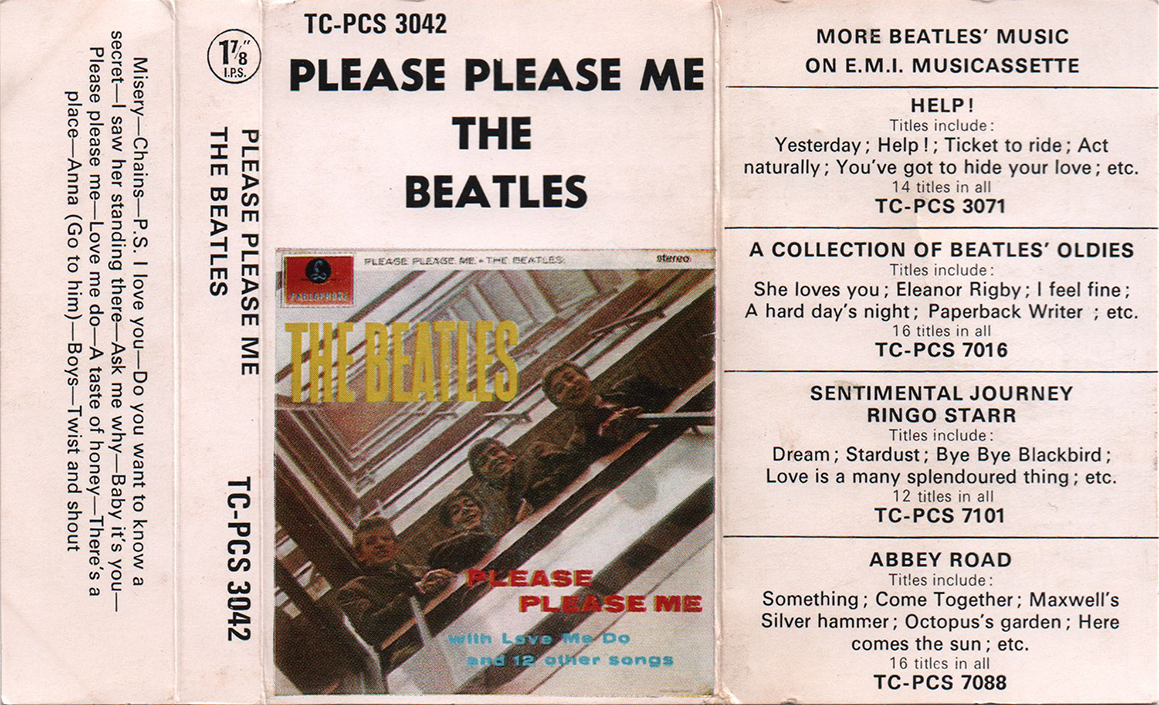 |
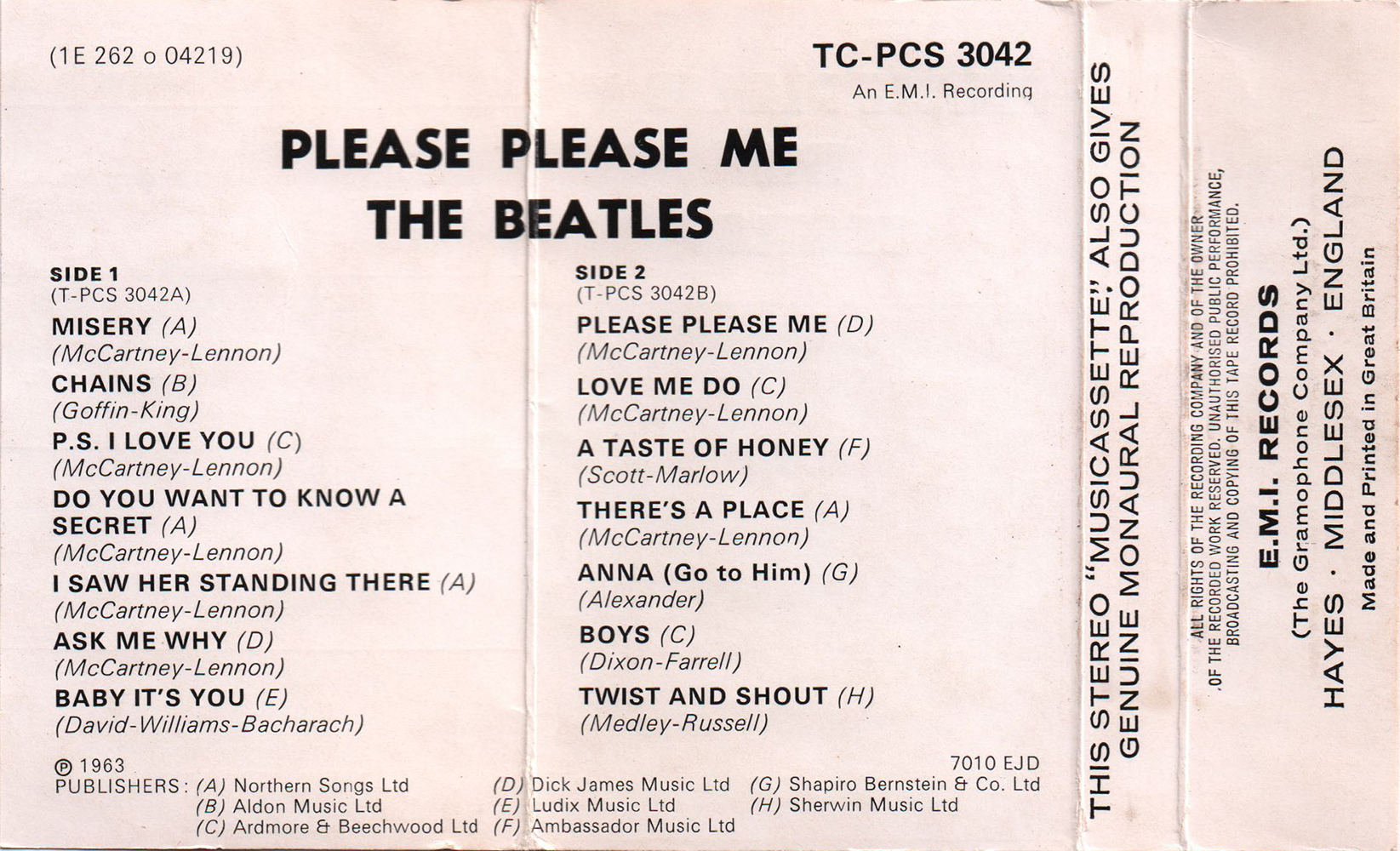 |
|||
| The 1970/71 cassettes had white inlays
and, aside from the small reproduction of the front cover,
no artwork was included nor the original liner notes. The
tracklistings were printed on the reverse of the inlay
whilst the foldovers advertised other available Beatles/solo
cassettes. |
||||
| INLAY: FRONT CLOSE UP | ||||
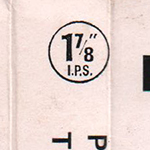 |
The
circular 1 7/8 " I.P.S. mark was printed at the spine. As the standard tape speed for a compact cassette is 1 ⅞ ips (1.875 inches per second). |
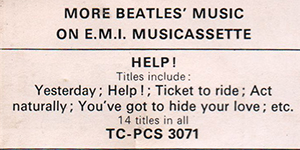 |
The tracklistings were
printed on the reverse of the inlay whilst the foldovers
advertised other available Beatles cassettes. |
|
| INLAY: FRONT CLOSE UP | ||||
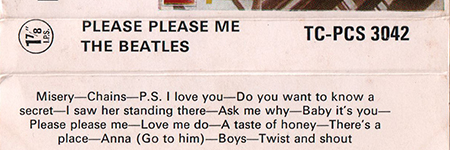 |
EMI
originally
issued the Beatles UK albums on cassette tape with
re-arranged running orders, the excuse being the need to
have two sides of equal length to avoid the problem of
listeners stopping the tape at the end of one side and
turning over to start mid-way through the opening track on
the reverse. |
|||
| INLAY: INSIDE CLOSE UP | ||||
 |
 |
Catalog number "TC-PCS 3042" and the EMI country code (*1) were printed on the inlay. |  |
Printer company's name and relrease date "7010 EJD (Ernest D. Jay)" was printed at the bottom of the inlay. |
 |
||||
| INLAY: INSIDE CLOSE UP | ||||
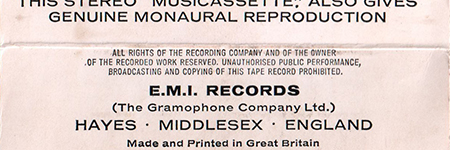 |
"E.M.I.
Records (The Gramophone Company Ltd.)" credit was printed at
the bottom of the inside of the inlay. |
|||
| LABEL CLOSE UP | ||||
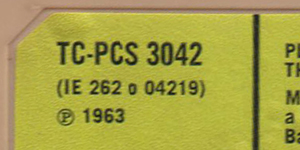 |
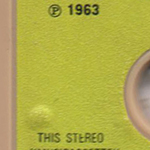 |
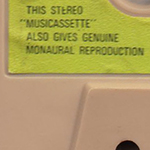 |
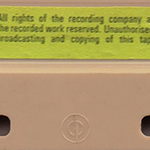 |
|
| The original 1st. cassettes was issued NO £ Parlophone logo. "IE" catalogue number in addition to the ordinary "TC-PCS 3042" EMI catalogue number. | Containing content as a prerecorded cassette is called "Musicassette" | The "DP(**)" logo can often be found moulded into cassette shells, especially during the early to mid 1970s. | ||
| LABEL CLOSE UP | ||||
| SIDE
1 |
SIDE 2 |
The
tracklistings
were printed on the reverse of the inlay. EMI originally
issued the Beatles UK albums on cassette tape with
re-arranged running orders. Has the 3 windows shell. |
||
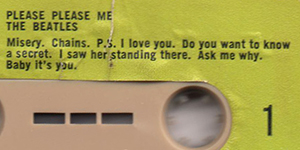 |
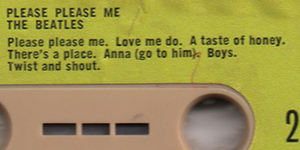 |
|||
| LABEL CLOSE UP | ||||
 |
"Made
in
England/Made in U.S.A" was not embossed the shell. |
|||
| OTHER ITEM | ||||
| - |
||||
| LABEL | Lemon Yellow Paper Label without Parlophone logo |
|||
| MIX | STEREO * except as noted |
|||
| RECORD COMPANY'S NAME | EMI Records (The Gramophone Company Ltd.) / An E.M.I. Recording | |||
| CENTRAL REMARK "SOLD IN U.K." |
- | |||
| RECORDING PUBLISHED CREDIT | (P) 1963 |
|||
| INLAY FORM | "white" inlay (Foldover) |
|||
| SHELL | Light Grey Shell with 3 windows
(Phillips made?) / embossed "dp" logo mark |
|||
| CASSETTE CASE |
"Norelco"
cases:
clear plastic at the front and around the spine area, and
black plastic at the rear. |
|||
| PRINTER CREDIT | Made and Printed in Great Britain / 7010
EJD |
|||
| COVER DESIGN/ PHOTO/ NOTES | Cover photo: Angus McBean |
|||
| PRODUCER | George Martin | |||
| COMMENTS | The original Beatles cassette
release of "Sgt. Peppers" in Oct. 1967, through "Abbey Road
(Nov. 1969)", "Let It Be (August 1970)", and the first
release of most of the other Beatles cassette albums in
Sept. and Oct, 1970, just months after EMI opened their new
tape duplicating facilities at Hayes in Middlesex in July,
1970.
Between 1966 and June 1970, EMI's early musicassettes were manufactured by the Dutch firm, Phillips themselves - the inventor and originator of the cassette. EMI opened its new tape duplicating facilities at Hayes, Middlesex in July 1970. All came with bright yellow paper label cassettes, their IE international catalogue numbers, and the newly designed, black box, EMI/Parlophone logo - although some were issued without the logo due to a lack of expensive letterpress blocks. The front and reverse of the inlays came in the "white inlay" design, for which the Let It Be inlay design of June 1970 was the template. The 1970/71 cassettes had white inlays and, aside from the small reproduction of the front cover, no artwork was included nor the original liner notes. Note the 7010 (or 7009) notation on the inside inlay followed by either EJD, G&L or DP. This was the number of the month/year of issue, followed by the printers initials ( Ernest J Day, Garrod & Lofthouse or Data Packaging). Advertising for other Beatles/solo albums was on the foldover front, and the EMI UK catalogue no. (TC-PCS-XXXX) was on the front cover at the top and on the spine. The spine also carried the tape speed, 1&7/8 ths in a circular logo style at the top. The cassette cases ("Norelco" cases) were clear plastic at the front and around the spine area, and black plastic at the rear. EMI originally issued the Beatles UK albums on cassette tape with re-arranged running orders, the excuse being the need to have two sides of equal length to avoid the problem of listeners stopping the tape at the end of one side and turning over to start mid-way through the opening track on the reverse. (*1) EMI country code: 1E 262 o 04219 The EMI country codes (introduced on 1 June, 1969): In most cases the EMI Codes are the first two letters of the record's catalog#. These EMI Country Codes were used to indicate the country in which the record was pressed. Note this doesn't necessarily means the record was also released in that country (from Discog). OC / 0C / 1E= UK (**)Data Packaging Corporation: (who also traded as Hellerman Data Packaging Ltd) supplied cassette and 8 track shells, tape and other components to the music industry. The "DP" logo can often be found moulded into cassette shells, especially during the early to mid 1970s. |
|||
|
TITLE
|
PLEASE PLEASE ME |
|||
| CATALOG NUMBER | TC-PCS 3042 / 1E 262 o 04219 |
|||
|
RELEASE DATE
|
late 1970? / Second Issue | |||
| TRACK LISTING | SIDE 1 | SIDE 2 | ||
| Misery [A2] |
Please Please Me [A7] |
|||
| Chains [A4] | Love Me Do [B1] (sim.stereo) | |||
| P.S. I Love You [B2] (sim. stereo) | A Taste Of Honey [B5] | |||
| Do You Want To Know A Secret [B4] | There's A Place [B6] | |||
| I Saw Her Standing There [A1] | Anna (Go To Him) [A3] | |||
| Ask Me
Why [A6] |
Boys [A5] | |||
| Baby It's You [B3] |
Twist And Shout [B7] |
|||
| CASSETTE CASE AND TAPE |
CASE FRONT | CASE BACK | SIDE 1 --> Click! | SIDE 2 --> Click! |
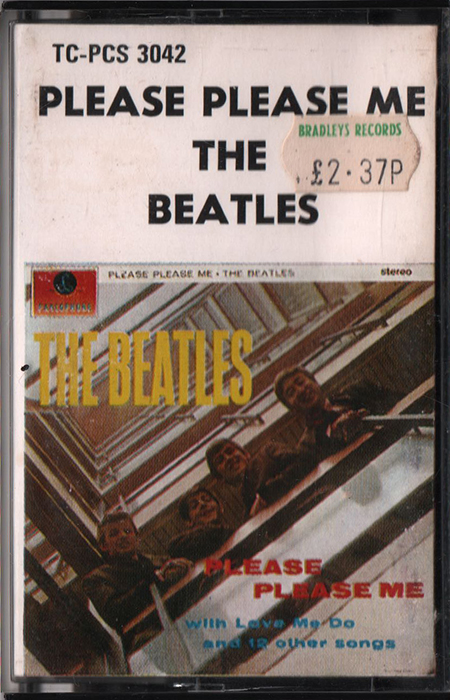 |
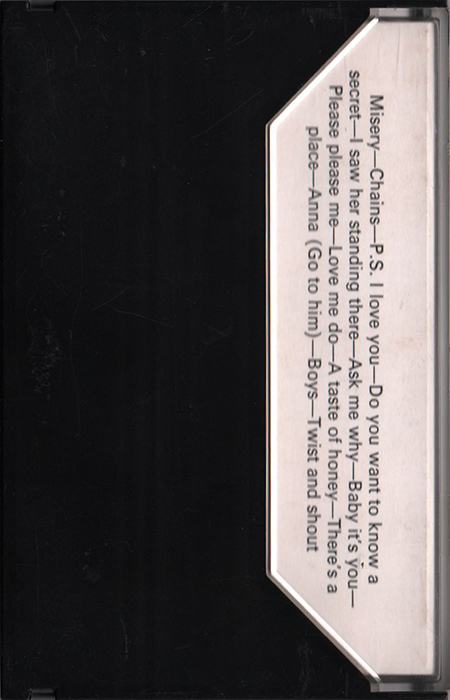 |
 |
 |
|
| The cassette cases ("Norelco" cases)
were clear plastic at the front and around the spine area,
and black plastic at the rear. |
This UK issue has Lemon
Yellow paper label without Parlophone logo |
|||
| INLAY |
INLAY: FRONT | INLAY: INSIDE |
||
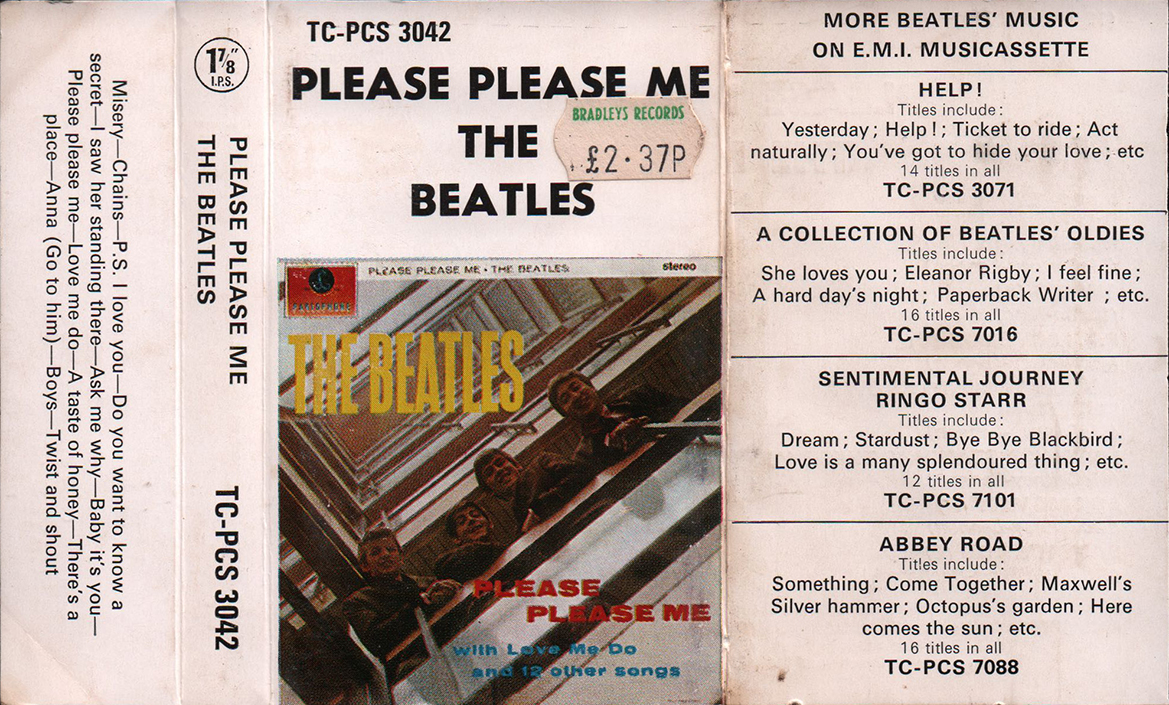 |
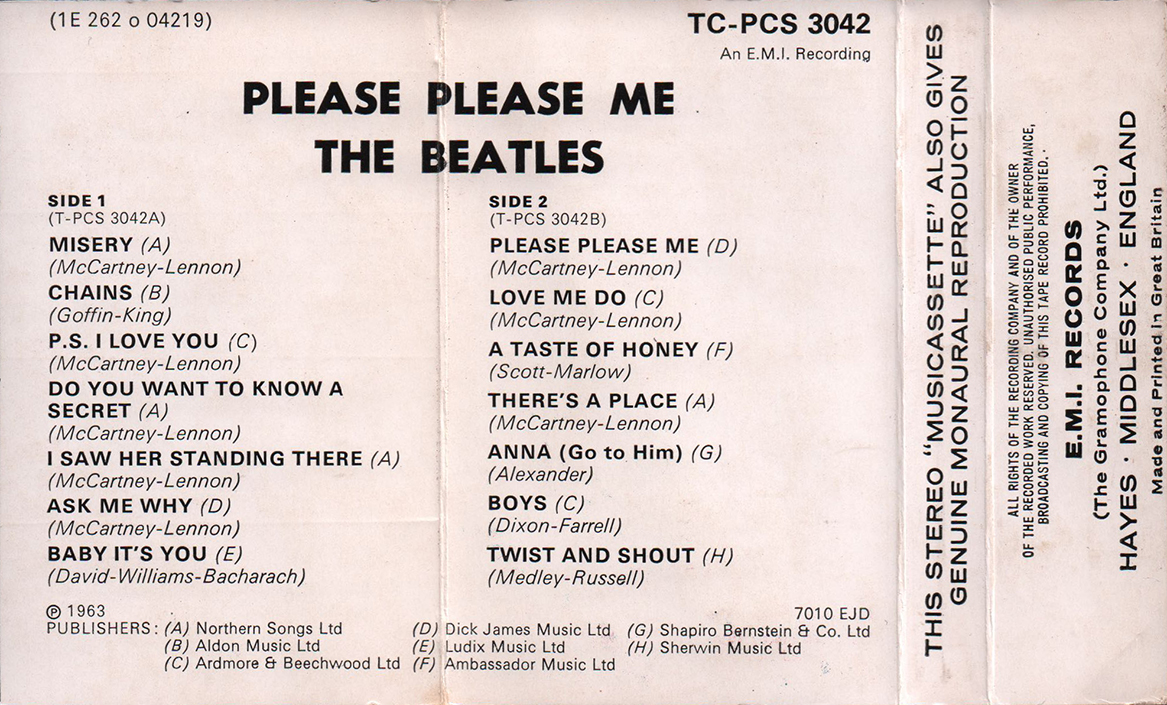 |
|||
| The 1970/71 cassettes had white inlays
and, aside from the small reproduction of the front cover,
no artwork was included nor the original liner notes. The
tracklistings were printed on the reverse of the inlay
whilst the foldovers advertised other available Beatles/solo
cassettes. |
||||
| INLAY: FRONT CLOSE UP | ||||
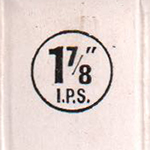 |
The
circular 1 7/8 " I.P.S. mark was printed at the spine. As the standard tape speed for a compact cassette is 1 ⅞ ips (1.875 inches per second). |
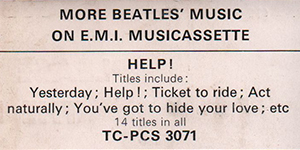 |
The tracklistings were
printed on the reverse of the inlay whilst the foldovers
advertised other available Beatles cassettes. |
|
| INLAY: FRONT CLOSE UP | ||||
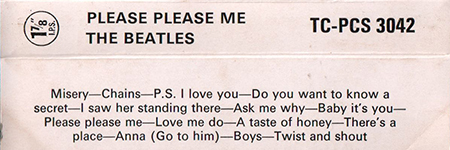 |
EMI
originally
issued the Beatles UK albums on cassette tape with
re-arranged running orders, the excuse being the need to
have two sides of equal length to avoid the problem of
listeners stopping the tape at the end of one side and
turning over to start mid-way through the opening track on
the reverse. |
|||
| INLAY: INSIDE CLOSE UP | ||||
 |
 |
Catalog number "TC-PCS 3042" and the EMI country code (*1) were printed on the inlay. |  |
Printer company's name and relrease date "7010 EJD (Ernest D. Jay)" was printed at the bottom of the inlay. |
| INLAY: INSIDE CLOSE UP | ||||
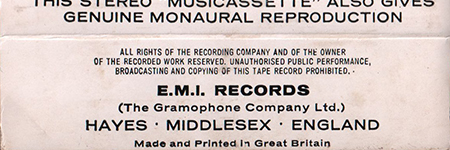 |
"E.M.I.
Records (The Gramophone Company Ltd.)" credit was printed at
the bottom of the inside of the inlay. |
|||
| LABEL CLOSE UP | ||||
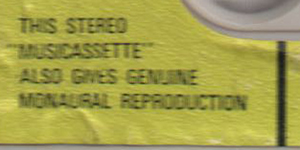 |
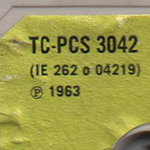 |
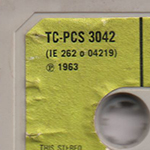 |
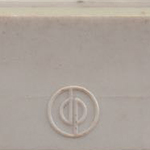 |
|
| Containing
content as a prerecorded cassette is called "Musicassette" |
The original 1st. cassettes was issued NO £ Parlophone logo. "IE" catalogue number in addition to the ordinary "TC-PCS 3042" EMI catalogue number. | The "DP(**)" logo can often be
found moulded into cassette shells, especially during the
early to mid 1970s. |
||
| LABEL CLOSE UP | ||||
| SIDE
1 |
SIDE 2 |
The tracklistings were printed on the reverse of the inlay. EMI originally issued the Beatles UK albums on cassette tape with re-arranged running orders. | ||
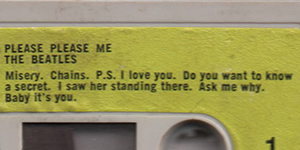 |
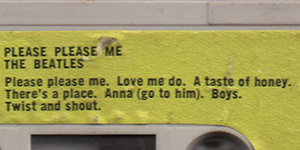 |
|||
| LABEL CLOSE UP | ||||
 |
"Made
in England or Made in U.S.A" was not embossed the shell. |
|||
| OTHER ITEM | ||||
| - |
||||
| LABEL | Lemon Yellow Paper Label without Parlophone logo |
|||
| MIX | STEREO * except as noted |
|||
| RECORD COMPANY'S NAME | EMI Records (The Gramophone Company Ltd.) / An E.M.I. Recording | |||
| CENTRAL REMARK "SOLD IN U.K." |
- | |||
| RECORDING PUBLISHED CREDIT | (P) 1963 |
|||
| INLAY FORM | "white" inlay (Foldover) |
|||
| SHELL | Light Grey Shell / embossed "dp"
logo mark |
|||
| CASSETTE CASE |
"Norelco"
cases:
clear plastic at the front and around the spine area, and
black plastic at the rear. |
|||
| PRINTER CREDIT | Made and Printed in Great Britain / 7010
EJD |
|||
| COVER DESIGN/ PHOTO/ NOTES | Cover photo: Angus McBean |
|||
| PRODUCER | George Martin | |||
| COMMENTS | The original Beatles cassette
release of "Sgt. Peppers" in Oct. 1967, through "Abbey Road
(Nov. 1969)", "Let It Be (August 1970)", and the first
release of most of the other Beatles cassette albums in
Sept. and Oct, 1970, just months after EMI opened their new
tape duplicating facilities at Hayes in Middlesex in July,
1970.
Between 1966 and June 1970, EMI's early musicassettes were manufactured by the Dutch firm, Phillips themselves - the inventor and originator of the cassette. EMI opened its new tape duplicating facilities at Hayes, Middlesex in July 1970. All came with bright yellow paper label cassettes, their IE international catalogue numbers, and the newly designed, black box, EMI/Parlophone logo - although some were issued without the logo due to a lack of expensive letterpress blocks. The front and reverse of the inlays came in the "white inlay" design, for which the Let It Be inlay design of June 1970 was the template. The 1970/71 cassettes had white inlays and, aside from the small reproduction of the front cover, no artwork was included nor the original liner notes. Note the 7010 (or 7009) notation on the inside inlay followed by either EJD, G&L or DP. This was the number of the month/year of issue, followed by the printers initials ( Ernest J Day, Garrod & Lofthouse or Data Packaging). Advertising for other Beatles/solo albums was on the foldover front, and the EMI UK catalogue no. (TC-PCS-XXXX) was on the front cover at the top and on the spine. The spine also carried the tape speed, 1&7/8 ths in a circular logo style at the top. The cassette cases ("Norelco" cases) were clear plastic at the front and around the spine area, and black plastic at the rear. EMI originally issued the Beatles UK albums on cassette tape with re-arranged running orders, the excuse being the need to have two sides of equal length to avoid the problem of listeners stopping the tape at the end of one side and turning over to start mid-way through the opening track on the reverse. (*1) EMI country code: 1E 262 o 04219 The EMI country codes (introduced on 1 June, 1969): In most cases the EMI Codes are the first two letters of the record's catalog#. These EMI Country Codes were used to indicate the country in which the record was pressed. Note this doesn't necessarily means the record was also released in that country (from Discog). OC / 0C / 1E= UK (**)Data Packaging Corporation: (who also traded as Hellerman Data Packaging Ltd) supplied cassette and 8 track shells, tape and other components to the music industry. The "DP" logo can often be found moulded into cassette shells, especially during the early to mid 1970s. |
|||
|
TITLE
|
PLEASE PLEASE ME |
|||
| CATALOG NUMBER | TC-PCS 3042 / 1E 262 o 04219 |
|||
|
RELEASE DATE
|
middle 1971 ? / Third Issue | |||
| TRACK LISTING | SIDE 1 | SIDE 2 | ||
| Misery [A2] |
Please Please Me [A7] |
|||
| Chains [A4] | Love Me Do [B1] (sim.stereo) | |||
| P.S. I Love You [B2] (sim. stereo) | A Taste Of Honey [B5] | |||
| Do You Want To Know A Secret [B4] | There's A Place [B6] | |||
| I Saw Her Standing There [A1] | Anna (Go To Him) [A3] | |||
| Ask Me
Why [A6] |
Boys [A5] | |||
| Baby It's You [B3] |
Twist And Shout [B7] |
|||
| CASSETTE CASE AND TAPE |
CASE FRONT | CASE BACK | SIDE 1 --> Click! | SIDE 2 --> Click! |
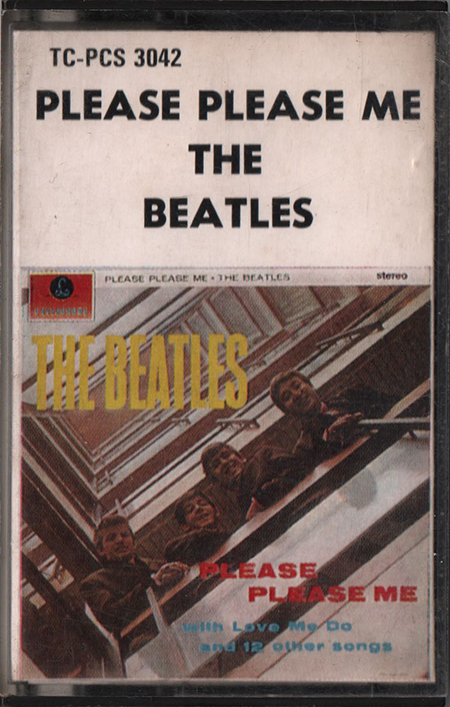 |
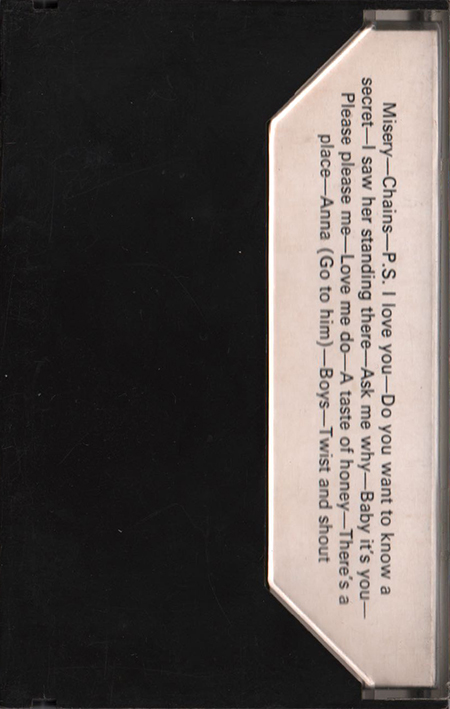 |
 |
 |
|
| The cassette cases ("Norelco" cases)
were clear plastic at the front and around the spine area,
and black plastic at the rear. |
This UK issue has Lemon Yellow paper label
with EMI/Parlophone logo |
|||
| INLAY |
INLAY: FRONT | INLAY: INSIDE |
||
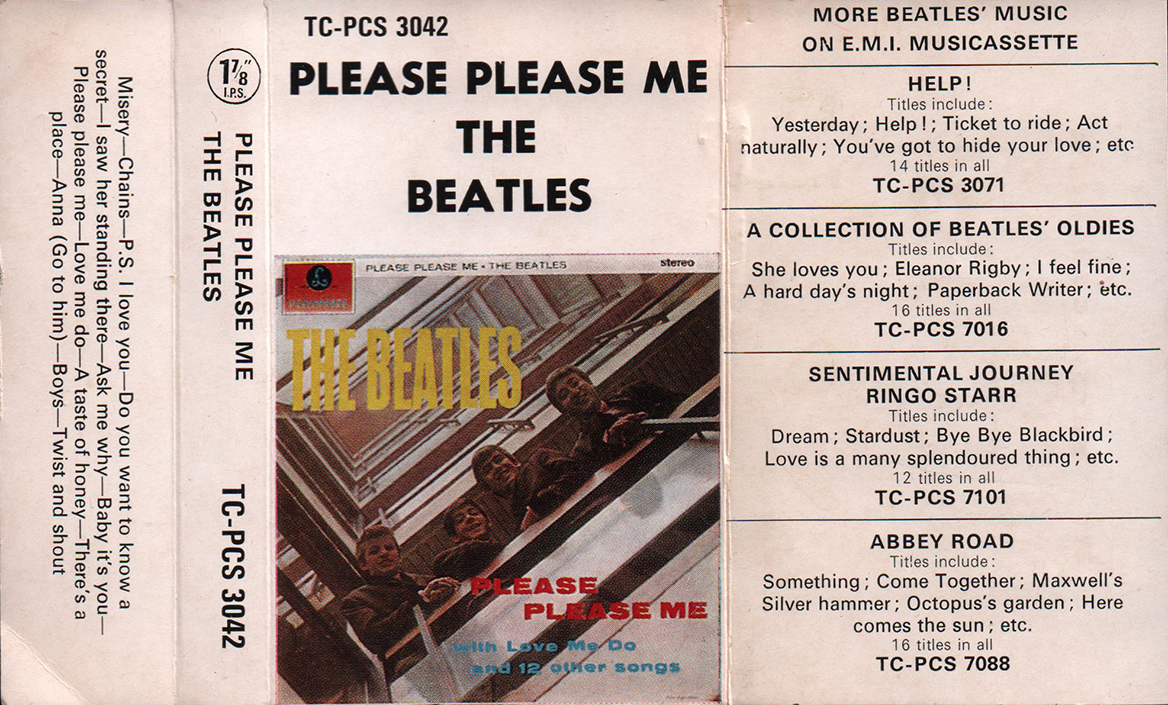 |
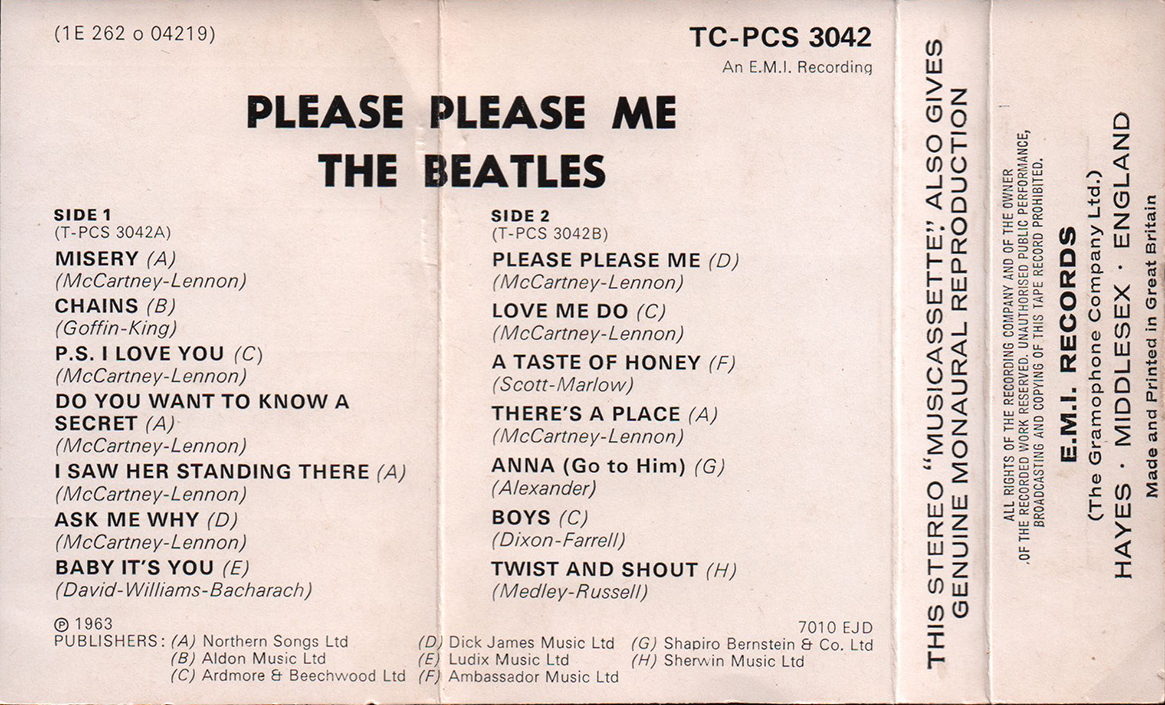 |
|||
| The 1970/71 cassettes had white inlays
and, aside from the small reproduction of the front cover,
no artwork was included nor the original liner notes. The
tracklistings were printed on the reverse of the inlay
whilst the foldovers advertised other available Beatles/solo
cassettes. |
||||
| INLAY: FRONT CLOSE UP | ||||
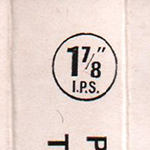 |
The
circular 1 7/8 " I.P.S. mark was printed at the spine. As the standard tape speed for a compact cassette is 1 ⅞ ips (1.875 inches per second). |
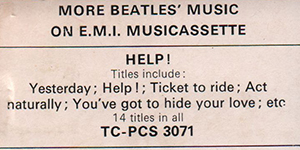 |
The tracklistings were
printed on the reverse of the inlay whilst the foldovers
advertised other available Beatles cassettes. |
|
| INLAY: FRONT CLOSE UP | ||||
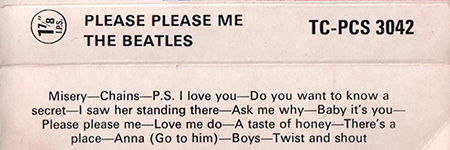 |
EMI
originally
issued
the
Beatles UK albums on cassette tape with re-arranged running
orders, the excuse being the need to have two sides of equal
length to avoid the problem of listeners stopping the tape
at the end of one side and turning over to start mid-way
through the opening track on the reverse. |
|||
| INLAY: INSIDE CLOSE UP | ||||
 |
 |
Catalog number "TC-PCS 3042" and the EMI country code (*1) were printed on the inlay. |  |
Printer company's name and relrease date "7010 EJD (Ernest D. Jay)" was printed at the bottom of the inlay. |
| INLAY: INSIDE CLOSE UP | ||||
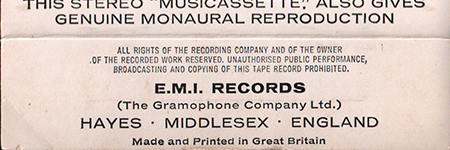 |
"E.M.I.
Records (The Gramophone Company Ltd.)" credit was printed at
the bottom of the inside of the inlay. |
|||
| LABEL CLOSE UP | ||||
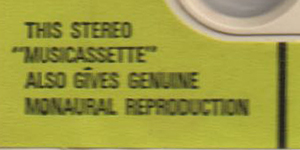 |
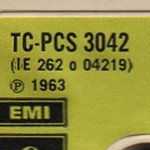 |
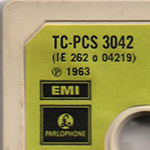 |
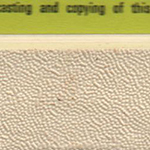 |
|
| Containing
content as a prerecorded cassette is called "Musicassette" |
The later 1970
onwards prints of the second issue had bright yellow paper
labels and carried the new black box EMI/Parlophone logo (or
NO logo at all.) |
The "DP(**)" logo was not
embossed on the cassette shells. |
||
| LABEL CLOSE UP | ||||
| SIDE
1 |
SIDE 2 |
The tracklistings were printed on the reverse of the inlay. EMI originally issued the Beatles UK albums on cassette tape with re-arranged running orders. | ||
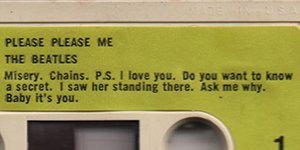 |
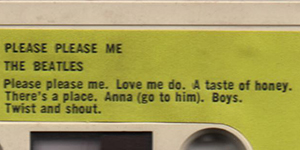 |
|||
| LABEL CLOSE UP | ||||
 |
"MADE
IN U.S.A." was embossed the shell. |
|||
| OTHER ITEM | ||||
| - |
||||
| LABEL | Lemon Yellow Paper Label with
EMI/Parlophone logo in black box |
|||
| MIX | STEREO * except as noted |
|||
| RECORD COMPANY'S NAME | EMI Records (The Gramophone Company Ltd.) / An E.M.I. Recording | |||
| CENTRAL REMARK "SOLD IN U.K." |
- | |||
| RECORDING PUBLISHED CREDIT | (P) 1963 |
|||
| INLAY FORM | "white" inlay (Foldover) |
|||
| SHELL | White Shell / embossed "MADE IN
USA" |
|||
| CASSETTE CASE |
"Norelco"
cases:
clear
plastic
at the front and around the spine area, and black plastic at
the rear. |
|||
| PRINTER CREDIT | Made and Printed in Great Britain / 7010
EJD |
|||
| COVER DESIGN/ PHOTO/ NOTES | Cover photo: Angus McBean |
|||
| PRODUCER | George Martin | |||
| COMMENTS | The original Beatles cassette
release of "Sgt. Peppers" in Oct. 1967, through "Abbey Road
(Nov. 1969)", "Let It Be (August 1970)", and the first
release of most of the other Beatles cassette albums in
Sept. and Oct, 1970, just months after EMI opened their new
tape duplicating facilities at Hayes in Middlesex in July,
1970.
Between 1966 and June 1970, EMI's early musicassettes were manufactured by the Dutch firm, Phillips themselves - the inventor and originator of the cassette. EMI opened its new tape duplicating facilities at Hayes, Middlesex in July 1970. All came with bright yellow paper label cassettes, their IE international catalogue numbers, and the newly designed, black box, EMI/Parlophone logo - although some were issued without the logo due to a lack of expensive letterpress blocks. The front and reverse of the inlays came in the "white inlay" design, for which the Let It Be inlay design of June 1970 was the template. The 1970/71 cassettes had white inlays and, aside from the small reproduction of the front cover, no artwork was included nor the original liner notes. Note the 7010 (or 7009) notation on the inside inlay followed by either EJD, G&L or DP. This was the number of the month/year of issue, followed by the printers initials ( Ernest J Day, Garrod & Lofthouse or Data Packaging). Advertising for other Beatles/solo albums was on the foldover front, and the EMI UK catalogue no. (TC-PCS-XXXX) was on the front cover at the top and on the spine. The spine also carried the tape speed, 1&7/8 ths in a circular logo style at the top. The cassette cases ("Norelco" cases) were clear plastic at the front and around the spine area, and black plastic at the rear. EMI originally issued the Beatles UK albums on cassette tape with re-arranged running orders, the excuse being the need to have two sides of equal length to avoid the problem of listeners stopping the tape at the end of one side and turning over to start mid-way through the opening track on the reverse. "MADE IN U.S.A." was embossed the shell. (*1) EMI country code: 1E 262 o 04219 The EMI country codes (introduced on 1 June, 1969): In most cases the EMI Codes are the first two letters of the record's catalog#. These EMI Country Codes were used to indicate the country in which the record was pressed. Note this doesn't necessarily means the record was also released in that country (from Discog). OC / 0C / 1E= UK (**)Data Packaging Corporation: (who also traded as Hellerman Data Packaging Ltd) supplied cassette and 8 track shells, tape and other components to the music industry. The "DP" logo can often be found moulded into cassette shells, especially during the early to mid 1970s. |
|||
|
TITLE
|
PLEASE PLEASE ME |
|||
| CATALOG NUMBER | TC-PCS 3042 / 1E 262 o 04219 |
|||
|
RELEASE DATE
|
middle 1971 ? / 4th Issue? | |||
| TRACK LISTING | SIDE 1 | SIDE 2 | ||
| Misery [A2] |
Please Please Me [A7] |
|||
| Chains [A4] | Love Me Do [B1] (sim.stereo) | |||
| P.S. I Love You [B2] (sim. stereo) | A Taste Of Honey [B5] | |||
| Do You Want To Know A Secret [B4] | There's A Place [B6] | |||
| I Saw Her Standing There [A1] | Anna (Go To Him) [A3] | |||
| Ask Me
Why [A6] |
Boys [A5] | |||
| Baby It's You [B3] |
Twist And Shout [B7] |
|||
| CASSETTE CASE AND TAPE |
CASE FRONT | CASE BACK | SIDE 1 --> Click! | SIDE 2 --> Click! |
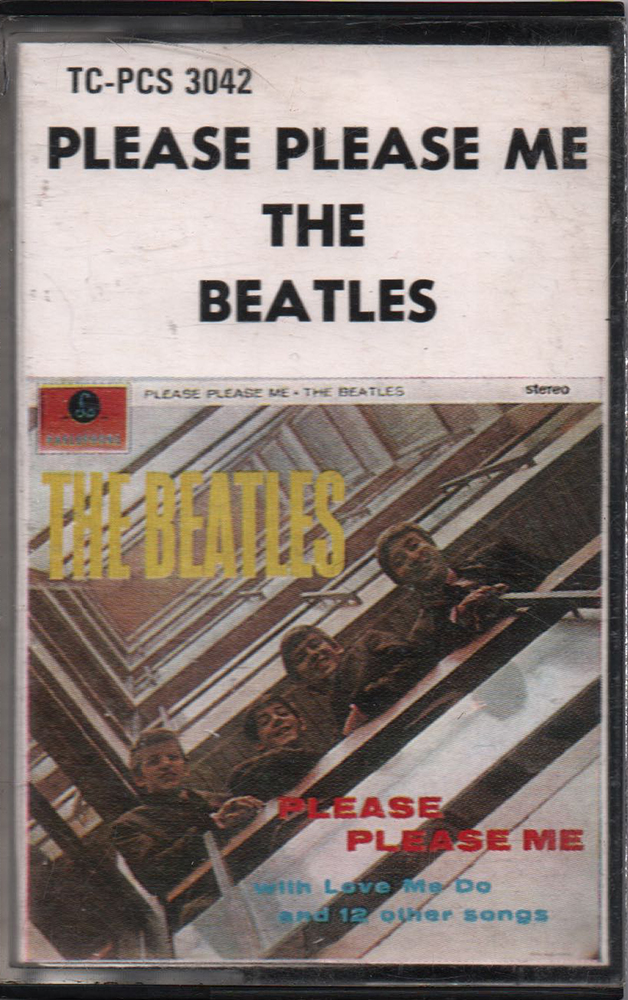 |
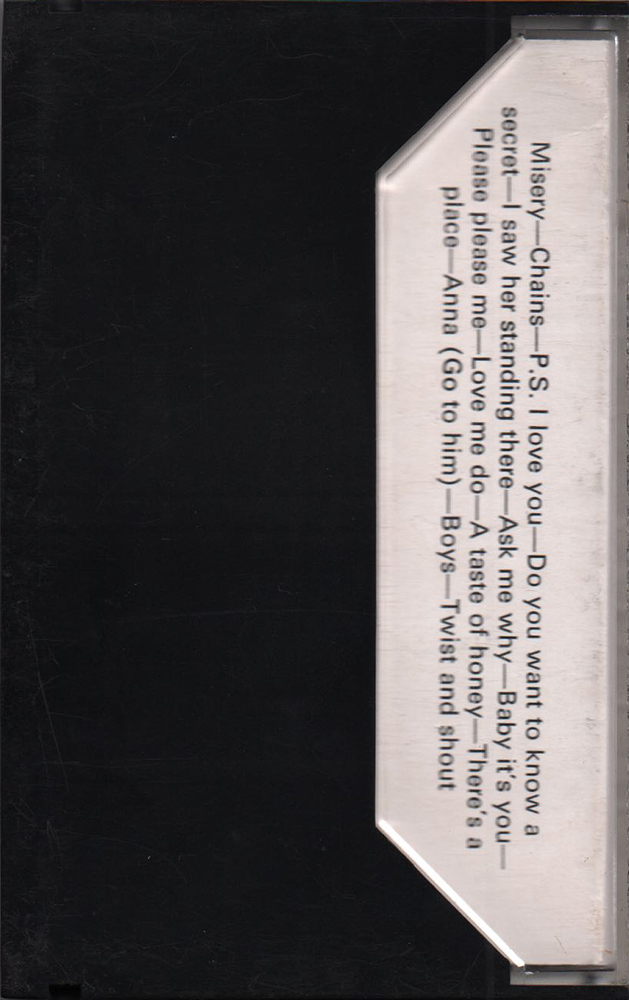 |
 |
 |
|
| The cassette cases ("Norelco" cases)
were clear plastic at the front and around the spine area,
and black plastic at the rear. |
This UK issue has Lemon Yellow paper label
with EMI/Parlophone logo |
|||
| INLAY |
INLAY: FRONT | INLAY: INSIDE |
||
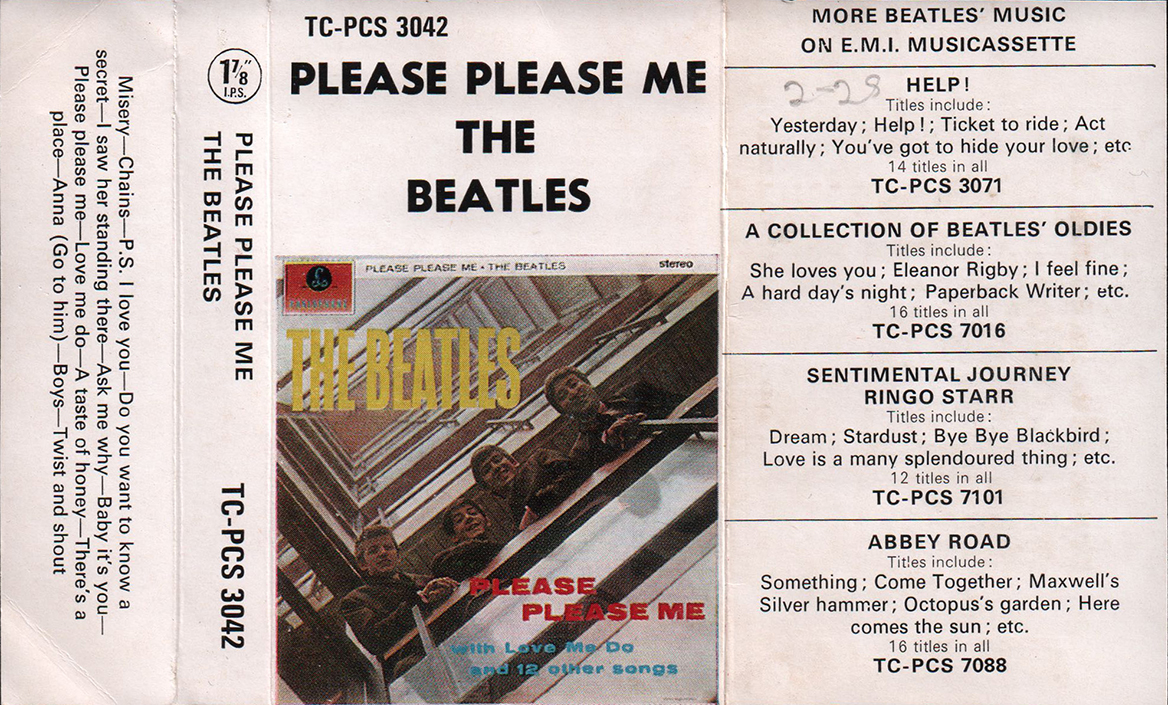 |
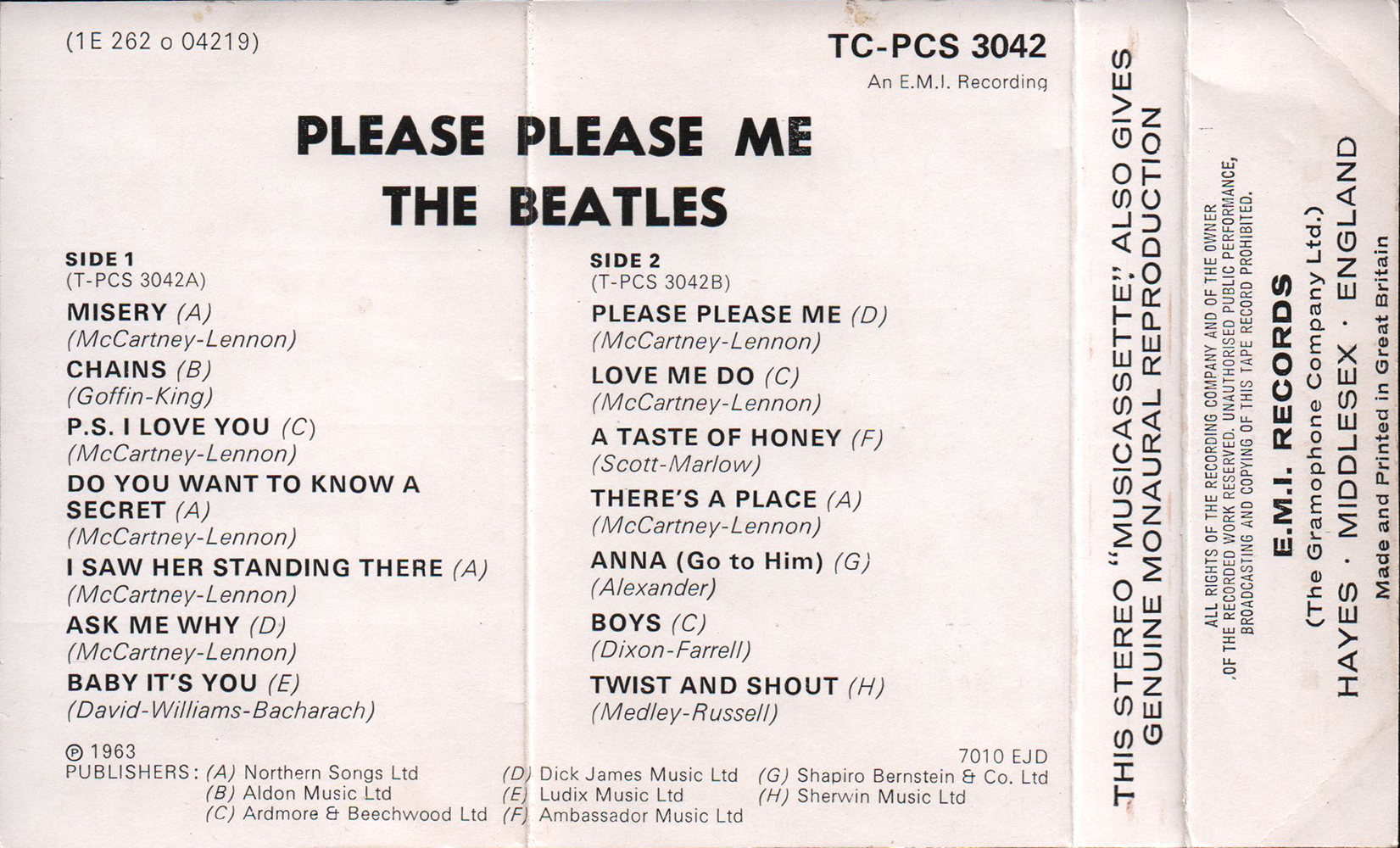 |
|||
| The 1970/71 cassettes had white inlays
and, aside from the small reproduction of the front cover,
no artwork was included nor the original liner notes. The
tracklistings were printed on the reverse of the inlay
whilst the foldovers advertised other available Beatles/solo
cassettes. |
||||
| INLAY: FRONT CLOSE UP | ||||
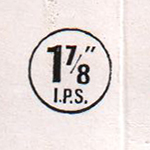 |
The
circular 1 7/8 " I.P.S. mark was printed at the spine. As the standard tape speed for a compact cassette is 1 ⅞ ips (1.875 inches per second). |
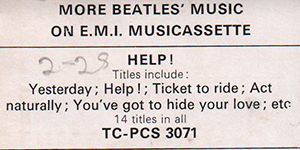 |
The tracklistings were
printed on the reverse of the inlay whilst the foldovers
advertised other available Beatles cassettes. |
|
| INLAY: FRONT CLOSE UP | ||||
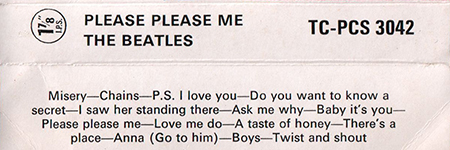 |
EMI
originally
issued
the Beatles UK albums on cassette tape with re-arranged
running orders, the excuse being the need to have two sides
of equal length to avoid the problem of listeners stopping
the tape at the end of one side and turning over to start
mid-way through the opening track on the reverse. |
|||
| INLAY: INSIDE CLOSE UP | ||||
 |
 |
Catalog number "TC-PCS 3042" and the EMI country code (*1) were printed on the inlay. |  |
Printer company's name and relrease date "7010 EJD (Ernest D. Jay)" was printed at the bottom of the inlay. |
 |
||||
| INLAY: INSIDE CLOSE UP | ||||
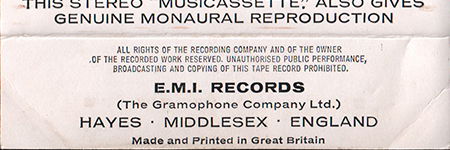 |
"E.M.I.
Records (The Gramophone Company Ltd.)" credit was printed at
the bottom of the inside of the inlay. |
|||
| LABEL CLOSE UP | ||||
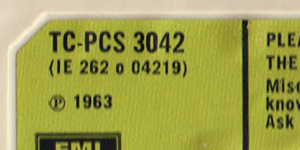 |
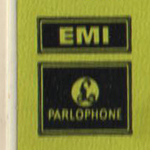 |
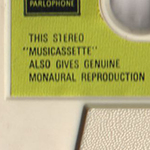 |
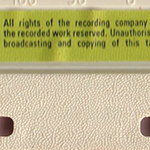 |
|
| The later 1970
onwards prints of the second issue had bright yellow paper
labels and carried the new black box EMI/Parlophone logo (or
NO logo at all.) |
Containing content as a prerecorded cassette is called "Musicassette" | The "DP(**)" logo was not embossed on the cassette shells. | ||
| LABEL CLOSE UP | ||||
| SIDE
1 |
SIDE 2 |
EMI
originally issued the Beatles UK albums on cassette tape
with re-arranged running orders. On side-1 of the label, with
the NEW track listing layout instead of
the lemon yellow type-1 label.
|
||
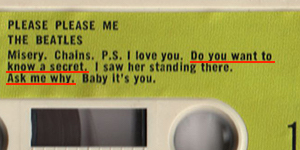 |
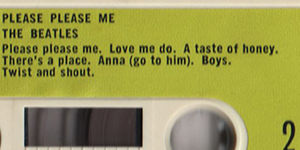 |
|||
| LABEL CLOSE UP | ||||
 |
"MADE
IN
U.S.A." was embossed the shell. |
|||
| OTHER ITEM | ||||
| - |
||||
| LABEL | Lemon Yellow Paper Label with
EMI/Parlophone logo in black box |
|||
| MIX | STEREO * except as noted |
|||
| RECORD COMPANY'S NAME | EMI Records (The Gramophone Company Ltd.) / An E.M.I. Recording | |||
| CENTRAL REMARK "SOLD IN U.K." |
- | |||
| RECORDING PUBLISHED CREDIT | (P) 1963 |
|||
| INLAY FORM | "white" inlay (Foldover) |
|||
| SHELL | White Shell / embossed "MADE IN
USA" |
|||
| CASSETTE CASE |
"Norelco"
cases:
clear
plastic at the front and around the spine area, and black
plastic at the rear. |
|||
| PRINTER CREDIT | Made and Printed in Great Britain / 7010
EJD |
|||
| COVER DESIGN/ PHOTO/ NOTES | Cover photo: Angus McBean |
|||
| PRODUCER | George Martin | |||
| COMMENTS | The original Beatles cassette
release of "Sgt. Peppers" in Oct. 1967, through "Abbey Road
(Nov. 1969)", "Let It Be (August 1970)", and the first
release of most of the other Beatles cassette albums in
Sept. and Oct, 1970, just months after EMI opened their new
tape duplicating facilities at Hayes in Middlesex in July,
1970.
Between 1966 and June 1970, EMI's early musicassettes were manufactured by the Dutch firm, Phillips themselves - the inventor and originator of the cassette. EMI opened its new tape duplicating facilities at Hayes, Middlesex in July 1970. All came with bright yellow paper label cassettes, their IE international catalogue numbers, and the newly designed, black box, EMI/Parlophone logo - although some were issued without the logo due to a lack of expensive letterpress blocks. The front and reverse of the inlays came in the "white inlay" design, for which the Let It Be inlay design of June 1970 was the template. The 1970/71 cassettes had white inlays and, aside from the small reproduction of the front cover, no artwork was included nor the original liner notes. Note the 7010 (or 7009) notation on the inside inlay followed by either EJD, G&L or DP. This was the number of the month/year of issue, followed by the printers initials ( Ernest J Day, Garrod & Lofthouse or Data Packaging). Advertising for other Beatles/solo albums was on the foldover front, and the EMI UK catalogue no. (TC-PCS-XXXX) was on the front cover at the top and on the spine. The spine also carried the tape speed, 1&7/8 ths in a circular logo style at the top. The cassette cases ("Norelco" cases) were clear plastic at the front and around the spine area, and black plastic at the rear. EMI originally issued the Beatles UK albums on cassette tape with re-arranged running orders, the excuse being the need to have two sides of equal length to avoid the problem of listeners stopping the tape at the end of one side and turning over to start mid-way through the opening track on the reverse. On side-1 of the label, with the NEW track listing layout instead of the lemon yellow type-2 label. "MADE IN U.S.A." was embossed the shell. (*1) EMI country code: 1E 262 o 04219 The EMI country codes (introduced on 1 June, 1969): In most cases the EMI Codes are the first two letters of the record's catalog#. These EMI Country Codes were used to indicate the country in which the record was pressed. Note this doesn't necessarily means the record was also released in that country (from Discog). OC / 0C / 1E= UK (**)Data Packaging Corporation: (who also traded as Hellerman Data Packaging Ltd) supplied cassette and 8 track shells, tape and other components to the music industry. The "DP" logo can often be found moulded into cassette shells, especially during the early to mid 1970s. |
|||
|
TITLE
|
PLEASE PLEASE ME |
|||
| CATALOG NUMBER | TC-PCS 3042 / 1E 262 o 04219 |
|||
|
RELEASE DATE
|
Late 1971 ? / 5th Issue | |||
| TRACK LISTING | SIDE 1 | SIDE 2 | ||
| Misery [A2] |
Please Please Me [A7] |
|||
| Chains [A4] | Love Me Do [B1] (sim.stereo) | |||
| P.S. I Love You [B2] (sim. stereo) | A Taste Of Honey [B5] | |||
| Do You Want To Know A Secret [B4] | There's A Place [B6] | |||
| I Saw Her Standing There [A1] | Anna (Go To Him) [A3] | |||
| Ask Me
Why [A6] |
Boys [A5] | |||
| Baby It's You [B3] |
Twist And Shout [B7] |
|||
| CASSETTE CASE AND TAPE |
CASE FRONT | CASE BACK | SIDE 1 --> Click! | SIDE 2 --> Click! |
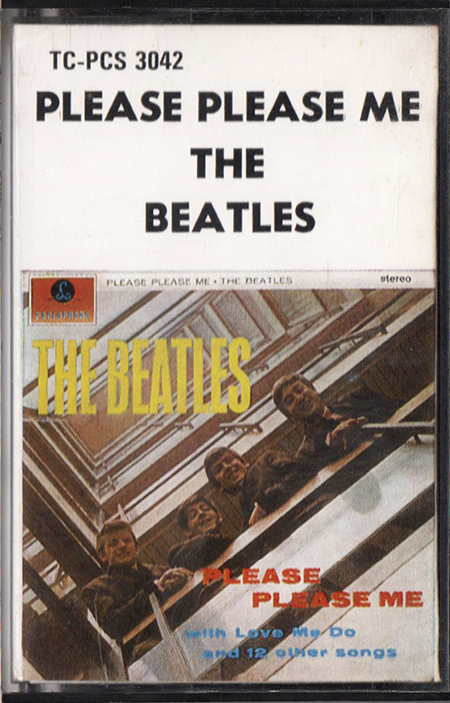 |
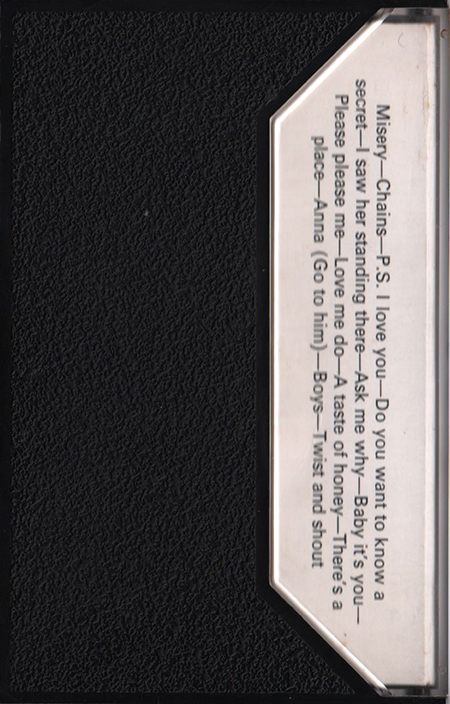 |
 |
 |
|
| The cassette cases ("Norelco" cases)
were clear plastic at the front and around the spine area,
and black plastic at the rear. |
This UK issue has Lemon Yellow paper label
with EMI/Parlophone logo |
|||
| INLAY |
INLAY: FRONT | INLAY: INSIDE |
||
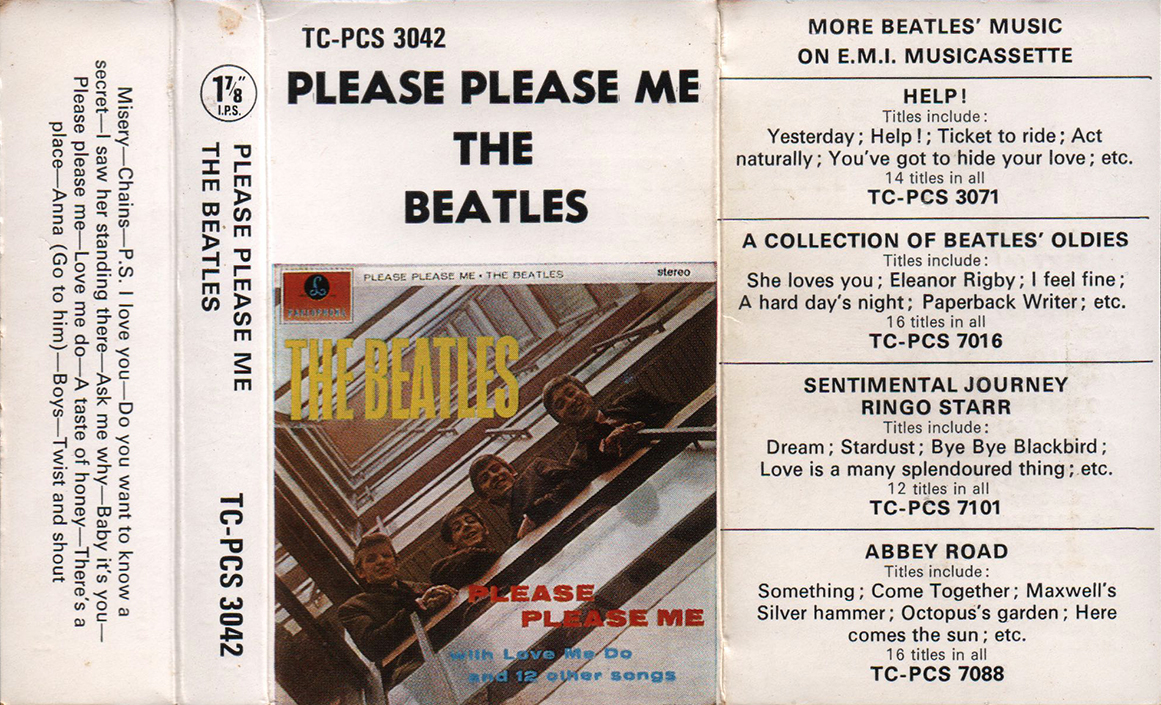 |
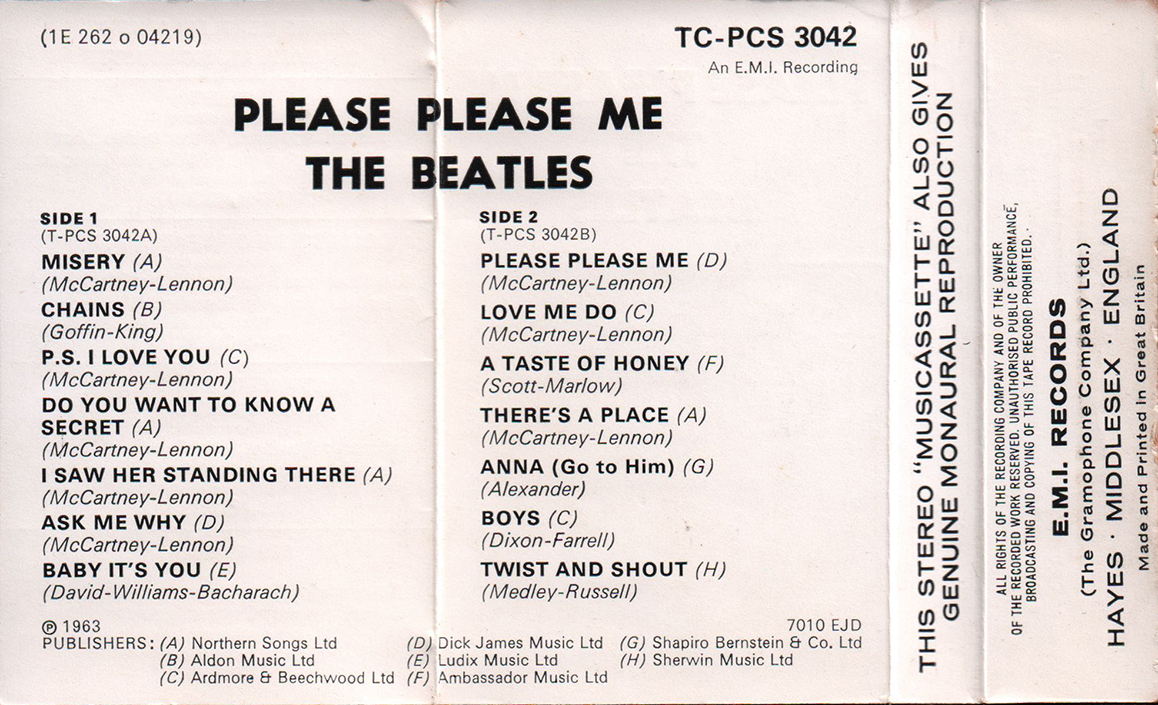 |
|||
| The 1970/71 cassettes had white inlays
and, aside from the small reproduction of the front cover,
no artwork was included nor the original liner notes. The
tracklistings were printed on the reverse of the inlay
whilst the foldovers advertised other available Beatles/solo
cassettes. |
||||
| INLAY: FRONT CLOSE UP | ||||
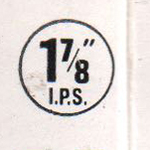 |
The
circular 1 7/8 " I.P.S. mark was printed at the spine. As the standard tape speed for a compact cassette is 1 ⅞ ips (1.875 inches per second). |
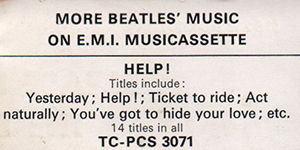 |
The tracklistings were
printed on the reverse of the inlay whilst the foldovers
advertised other available Beatles cassettes. |
|
| INLAY: FRONT CLOSE UP | ||||
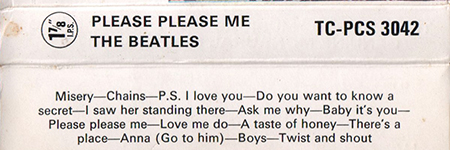 |
EMI
originally
issued
the
Beatles UK albums on cassette tape with re-arranged running
orders, the excuse being the need to have two sides of equal
length to avoid the problem of listeners stopping the tape
at the end of one side and turning over to start mid-way
through the opening track on the reverse. |
|||
| INLAY: INSIDE CLOSE UP | ||||
 |
 |
Catalog number "TC-PCS 3042" and the EMI country code (*1) were printed on the inlay. |  |
Printer company's name and relrease date "7010 EJD (Ernest D. Jay)" was printed at the bottom of the inlay. |
| INLAY: INSIDE CLOSE UP | ||||
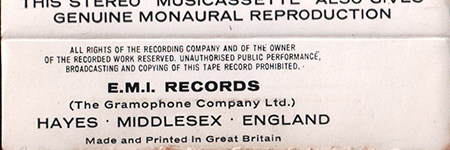 |
"E.M.I.
Records (The Gramophone Company Ltd.)" credit was printed at
the bottom of the inside of the inlay. |
|||
| LABEL CLOSE UP | ||||
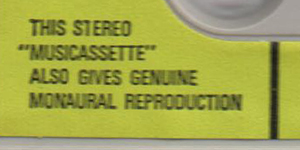 |
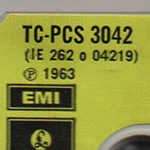 |
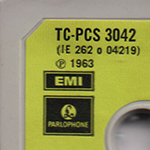 |
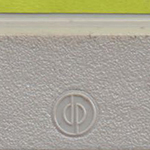 |
|
| Containing
content as a prerecorded cassette is called "Musicassette" |
The later 1970
onwards prints of the second issue had bright yellow paper
labels and carried the new black box EMI/Parlophone logo (or
NO logo at all.) |
The "DP(**)" logo can
often be found moulded into cassette shells, especially
during the early to mid 1970s. |
||
| LABEL CLOSE UP | ||||
| SIDE
1 |
SIDE 2 |
EMI originally issued the Beatles UK albums on cassette tape with re-arranged running orders. The song track listing layout has returned to the first track order when the cassette tape was released (Oct. 1970). | ||
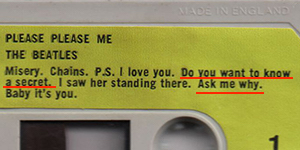 |
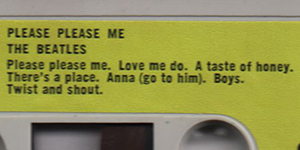 |
|||
| LABEL CLOSE UP | ||||
 |
"MADE
IN
ENGLAND" was embossed the shell. |
|||
| OTHER ITEM | ||||
| - |
||||
| LABEL | Lemon Yellow Paper Label with
EMI/Parlophone logo in black box |
|||
| MIX | STEREO * except as noted |
|||
| RECORD COMPANY'S NAME | EMI Records (The Gramophone Company Ltd.) / An E.M.I. Recording | |||
| CENTRAL REMARK "SOLD IN U.K." |
- | |||
| RECORDING PUBLISHED CREDIT | (P) 1963 |
|||
| INLAY FORM | "white" inlay (Foldover) |
|||
| SHELL | Light Grey Shell / embossed "MADE
IN ENGLAND" and "dp" logo mark |
|||
| CASSETTE CASE |
"Norelco"
cases:
clear
plastic
at the front and around the spine area, and black plastic at
the rear. |
|||
| PRINTER CREDIT | Made and Printed in Great Britain / 7010
EJD |
|||
| COVER DESIGN/ PHOTO/ NOTES | Cover photo: Angus McBean |
|||
| PRODUCER | George Martin | |||
| COMMENTS | The original Beatles cassette
release of "Sgt. Peppers" in Oct. 1967, through "Abbey Road
(Nov. 1969)", "Let It Be (August 1970)", and the first
release of most of the other Beatles cassette albums in
Sept. and Oct, 1970, just months after EMI opened their new
tape duplicating facilities at Hayes in Middlesex in July,
1970.
Between 1966 and June 1970, EMI's early musicassettes were manufactured by the Dutch firm, Phillips themselves - the inventor and originator of the cassette. EMI opened its new tape duplicating facilities at Hayes, Middlesex in July 1970. All came with bright yellow paper label cassettes, their IE international catalogue numbers, and the newly designed, black box, EMI/Parlophone logo - although some were issued without the logo due to a lack of expensive letterpress blocks. The front and reverse of the inlays came in the "white inlay" design, for which the Let It Be inlay design of June 1970 was the template. The 1970/71 cassettes had white inlays and, aside from the small reproduction of the front cover, no artwork was included nor the original liner notes. Note the 7010 (or 7009) notation on the inside inlay followed by either EJD, G&L or DP. This was the number of the month/year of issue, followed by the printers initials ( Ernest J Day, Garrod & Lofthouse or Data Packaging). Advertising for other Beatles/solo albums was on the foldover front, and the EMI UK catalogue no. (TC-PCS-XXXX) was on the front cover at the top and on the spine. The spine also carried the tape speed, 1&7/8 ths in a circular logo style at the top. The cassette cases ("Norelco" cases) were clear plastic at the front and around the spine area, and black plastic at the rear. EMI originally issued the Beatles UK albums on cassette tape with re-arranged running orders, the excuse being the need to have two sides of equal length to avoid the problem of listeners stopping the tape at the end of one side and turning over to start mid-way through the opening track on the reverse. The song track listing layout has returned to the first track order when the cassette tape was released (Oct. 1970). (maybe) "MADE IN ENGLAND" was embossed the shell. The 1970/71 cassettes had white inlays and, aside from the small reproduction of the front cover, no artwork was included nor the original liner notes. The tracklistings were printed on the reverse of the inlay whilst the foldovers advertised other available Beatles/solo cassettes. The EMI UK catalogue no. (TC-PCS-XXXX) was on the front cover at the top and on the spine. The spine also carried the tape speed, 1 7/8" IPS in a circular logo style at the top. The cassette cases ("Norelco" cases) were clear plastic at the front and around the spine area, and black plastic at the rear. The two exceptions to this generally adopted style for the white inlays was Revolver - which had a black background above the front cover album picture with no TC-PCS-7009 and a black coloured inlay spine with it, and The Beatles White album, which had its tracklisting on the front foldover where normally the advertising for the other albums would be. (*1) EMI country code: 1E 262 o 04219 The EMI country codes (introduced on 1 June, 1969): In most cases the EMI Codes are the first two letters of the record's catalog#. These EMI Country Codes were used to indicate the country in which the record was pressed. Note this doesn't necessarily means the record was also released in that country (from Discog). OC / 0C / 1E= UK (**)Data Packaging Corporation: (who also traded as Hellerman Data Packaging Ltd) supplied cassette and 8 track shells, tape and other components to the music industry. The "DP" logo can often be found moulded into cassette shells, especially during the early to mid 1970s. |
|||
|
TITLE
|
PLEASE PLEASE ME |
|||
| CATALOG NUMBER | TC-PCS 3042 / 1E 262 o 04219 |
|||
|
RELEASE DATE
|
Late 1971 ? / 6th Issue | |||
| TRACK LISTING | SIDE 1 | SIDE 2 | ||
| Misery [A2] |
Please Please Me [A7] |
|||
| Chains [A4] | Love Me Do [B1] (sim.stereo) | |||
| P.S. I Love You [B2] (sim. stereo) | A Taste Of Honey [B5] | |||
| Do You Want To Know A Secret [B4] | There's A Place [B6] | |||
| I Saw Her Standing There [A1] | Anna (Go To Him) [A3] | |||
| Ask Me
Why [A6] |
Boys [A5] | |||
| Baby It's You [B3] |
Twist And Shout [B7] |
|||
| CASSETTE CASE AND TAPE |
CASE FRONT | CASE BACK | SIDE 1 --> Click! | SIDE 2 --> Click! |
 |
 |
 |
 |
|
| The cassette cases ("Norelco" cases)
were clear plastic at the front and around the spine area,
and black plastic at the rear. |
This UK issue has Lemon Yellow paper label
with EMI/Parlophone logo |
|||
| INLAY |
INLAY: FRONT | INLAY: INSIDE |
||
 |
 |
|||
| The 1970/71 cassettes had white inlays
and, aside from the small reproduction of the front cover,
no artwork was included nor the original liner notes. The
tracklistings were printed on the reverse of the inlay
whilst the foldovers advertised other available Beatles/solo
cassettes. |
||||
| INLAY: FRONT CLOSE UP | ||||
 |
The
circular 1 7/8 " I.P.S. mark was printed at the spine. As the standard tape speed for a compact cassette is 1 ⅞ ips (1.875 inches per second). |
 |
The tracklistings were
printed on the reverse of the inlay whilst the foldovers
advertised other available Beatles cassettes. |
|
| INLAY: FRONT CLOSE UP | ||||
 |
EMI
originally
issued
the
Beatles
UK albums on cassette tape with re-arranged running orders,
the excuse being the need to have two sides of equal length
to avoid the problem of listeners stopping the tape at the
end of one side and turning over to start mid-way through
the opening track on the reverse. |
|||
| INLAY: INSIDE CLOSE UP | ||||
 |
 |
Catalog number "TC-PCS 3042" and the EMI country code (*1) were printed on the inlay. |  |
Printer company's name and relrease date "7010 EJD (Ernest D. Jay)" was printed at the bottom of the inlay. |
 |
||||
| INLAY: INSIDE CLOSE UP | ||||
 |
"E.M.I.
Records (The Gramophone Company Ltd.)" credit was printed at
the bottom of the inside of the inlay. |
|||
| LABEL CLOSE UP | ||||
 |
 |
 |
 |
|
| Containing
content as a prerecorded cassette is called "Musicassette" |
The later 1970
onwards prints of the second issue had bright yellow paper
labels and carried the new black box EMI/Parlophone logo (or
NO logo at all.) |
The "DP(**)" logo can
often be found moulded into cassette shells, especially
during the early to mid 1970s. |
||
| LABEL CLOSE UP | ||||
| SIDE
1 |
SIDE 2 |
EMI
originally issued the Beatles UK albums on cassette tape
with re-arranged running orders. On side-1 of the label,
with the NEW track listing layout instead of the lemon
yellow type-1 label. |
||
 |
 |
|||
| LABEL CLOSE UP | ||||
 |
 |
"MADE IN ENGLAND" was embossed the
shell on both sides. |
||
| OTHER ITEM | ||||
| - |
||||
| LABEL | Lemon Yellow Paper Label with
EMI/Parlophone logo in black box |
|||
| MIX | STEREO * except as noted |
|||
| RECORD COMPANY'S NAME | EMI Records (The Gramophone Company Ltd.) / An E.M.I. Recording | |||
| CENTRAL REMARK "SOLD IN U.K." |
- | |||
| RECORDING PUBLISHED CREDIT | (P) 1963 |
|||
| INLAY FORM | "white" inlay (Foldover) |
|||
| SHELL | Light Grey Shell / embossed "MADE
IN ENGLAND" and "dp" logo mark |
|||
| CASSETTE CASE |
"Norelco"
cases:
clear
plastic
at
the front and around the spine area, and black plastic at
the rear. |
|||
| PRINTER CREDIT | Made and Printed in Great Britain / 7010
EJD |
|||
| COVER DESIGN/ PHOTO/ NOTES | Cover photo: Angus McBean |
|||
| PRODUCER | George Martin | |||
| COMMENTS | The original Beatles cassette
release of "Sgt. Peppers" in Oct. 1967, through "Abbey Road
(Nov. 1969)", "Let It Be (August 1970)", and the first
release of most of the other Beatles cassette albums in
Sept. and Oct, 1970, just months after EMI opened their new
tape duplicating facilities at Hayes in Middlesex in July,
1970.
Between 1966 and June 1970, EMI's early musicassettes were manufactured by the Dutch firm, Phillips themselves - the inventor and originator of the cassette. EMI opened its new tape duplicating facilities at Hayes, Middlesex in July 1970. All came with bright yellow paper label cassettes, their IE international catalogue numbers, and the newly designed, black box, EMI/Parlophone logo - although some were issued without the logo due to a lack of expensive letterpress blocks. The front and reverse of the inlays came in the "white inlay" design, for which the Let It Be inlay design of June 1970 was the template. The 1970/71 cassettes had white inlays and, aside from the small reproduction of the front cover, no artwork was included nor the original liner notes. Note the 7010 (or 7009) notation on the inside inlay followed by either EJD, G&L or DP. This was the number of the month/year of issue, followed by the printers initials ( Ernest J Day, Garrod & Lofthouse or Data Packaging). Advertising for other Beatles/solo albums was on the foldover front, and the EMI UK catalogue no. (TC-PCS-XXXX) was on the front cover at the top and on the spine. The spine also carried the tape speed, 1&7/8 ths in a circular logo style at the top. The cassette cases ("Norelco" cases) were clear plastic at the front and around the spine area, and black plastic at the rear. EMI originally issued the Beatles UK albums on cassette tape with re-arranged running orders. On side-1 of the label, with the NEW track listing layout instead of the lemon yellow type-1 label. "MADE IN ENGLAND" was embossed the shell. The 1970/71 cassettes had white inlays and, aside from the small reproduction of the front cover, no artwork was included nor the original liner notes. The tracklistings were printed on the reverse of the inlay whilst the foldovers advertised other available Beatles/solo cassettes. The EMI UK catalogue no. (TC-PCS-XXXX) was on the front cover at the top and on the spine. The spine also carried the tape speed, 1 7/8" IPS in a circular logo style at the top. The cassette cases ("Norelco" cases) were clear plastic at the front and around the spine area, and black plastic at the rear. The two exceptions to this generally adopted style for the white inlays was Revolver - which had a black background above the front cover album picture with no TC-PCS-7009 and a black coloured inlay spine with it, and The Beatles White album, which had its tracklisting on the front foldover where normally the advertising for the other albums would be. (*1) EMI country code: 1E 262 o 04219 The EMI country codes (introduced on 1 June, 1969): In most cases the EMI Codes are the first two letters of the record's catalog#. These EMI Country Codes were used to indicate the country in which the record was pressed. Note this doesn't necessarily means the record was also released in that country (from Discog). OC / 0C / 1E= UK (**)Data Packaging Corporation: (who also traded as Hellerman Data Packaging Ltd) supplied cassette and 8 track shells, tape and other components to the music industry. The "DP" logo can often be found moulded into cassette shells, especially during the early to mid 1970s. |
|||
